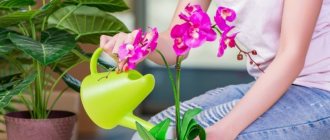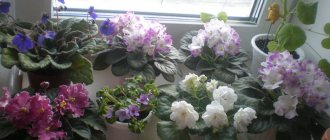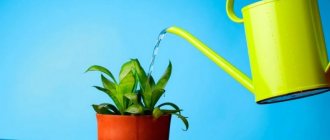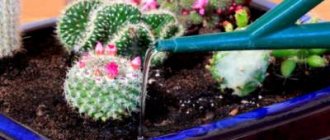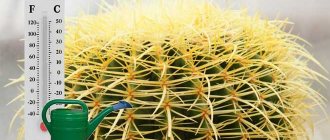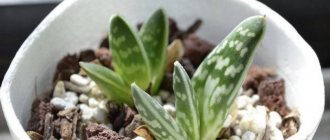Introducing the review: “Watering indoor plants.” We'll tell you how often you need to water indoor plants, how best to do it, and much more. Also see in a separate article what water to water indoor plants for better development.
ADDITIONS TO THE ARTICLE:
1. WHAT WATER IS NEEDED FOR WATERING HOUSEPLANTS? HARDNESS, TEMPERATURE, ETC.
2. HOW TO WATER HOUSE PLANTS? REVIEW OF IRRIGATION METHODS!
3. HOW TO WATER PLANTS AND FLOWERS DURING A VACATION OR BUSINESS TRIP?
Why do you need to water flowers at home?
First, you need to understand why watering indoor plants is necessary. Plants need water for various reasons. Firstly, it is the main component of tissues: some plants, primarily herbaceous ones with soft stems, consist of up to 90% water.
Water also has a nutritional function. The mineral salts contained in the soil are dissolved in it, and it carries them from the roots to the leaves of plants. Finally, water plays an important role in the respiration process: it evaporates through the stomata located on the underside of the leaves and humidifies the air surrounding the plant.
What happens if you don’t regularly water your indoor flowers? If a houseplant is not watered enough, then, as practice shows, the leaves and flowers become flabby and drooping, and the stems of herbaceous species fall off. Then the leaves wither and fall off.
In cacti and succulent plants, which usually contain a lot of water, with a lack of moisture, you can observe a clearly noticeable wrinkling of the entire plant.
But before, with the above-mentioned symptoms, you immediately grab a jug of water and water your indoor plants as much as possible, with all your heart, you need to think about the fact that excessive watering of house flowers, leading to excess moisture, is also harmful to crops, and the same symptoms appear the same as with a lack of moisture.
Why this happens can be explained simply: with excessive watering and spraying of indoor plants, all the pores in the soil that previously contained air are filled with water. In such a case, botanists talk about “stagnant waterlogging of the soil.” In such soil, which does not contain air, the root system can no longer function normally and absorb water. When houseplants are overwatered, the supply to the upper part of the plant stops, it dries out, while the lower part “sinks.”
You can find out how sensitively plants react to waterlogging and drying out of the soil from the recommendations for caring for individual species.
The next section of the article is devoted to how often you need to water indoor flowers, and by what factors you can distribute the level of water consumption.
How often to water flowers in summer
The frequency of watering is directly related to three factors:
- Weather conditions. Summer can be very dry, when moisture is required daily, or rainy, which makes it possible to do without irrigation altogether.
- Soil type and composition. Light soil options (sandy and sandy loam) require frequent watering, but with little water consumption. Moisture leaves such soil quickly. The same cannot be said about clay and peaty soils, then watering will be required less often, but with a larger volume of water.
- Type of flower culture. Here it is important to focus not only on a specific species, but even on the variety. Some flowers are distinguished by their love of moisture, while others are very afraid of excessive watering.
It is worth noting that in extreme heat leading to drought, all garden plants need additional watering, even those that require less irrigation during their growing season. However, it is important to know how to properly moisturize during dry periods, in particular, whether it is possible to water flowers during the day. Moisturizing during the daytime (especially under the scorching sun) will certainly lead to a burn, so this is strictly not recommended. The optimal time for watering outdoor plants in the summer is in the morning before 8 o’clock and in the evening after 18 o’clock, when the sun leaves its active phase.
How often should you water indoor flowers: factors for water consumption by house plants
Precisely because there are no uniform recipes for properly watering home flowers, you should familiarize yourself with some basic rules, which are discussed below. They will help develop the sense of proportion necessary for watering.
How often you need to fertilize and when to replant crops can be determined exactly. But the frequency of watering depends on so many reasons that you will only find approximate information in books. You will learn whether the plant should be watered a lot or a little.
How often you need to water your indoor plants is determined by the following factors.
- Pot material. The same plant in a clay pot requires more water than in a plastic pot, as water evaporates through the porous clay walls.
- Pot size. A plant in a large pot needs more water than a plant in a small one.
- Location. On a southern window, plants most often require more water than on less lit eastern, western, and even more so northern ones.
- Temperature. Plants require more water in a warm room than in a cool room.
- Weather. On a hot summer day, the plant needs more water than on a cool and rainy day. In the heat, plant leaves evaporate more water, which means you need to water indoor flowers more often during this period, as experienced plant growers advise.
- Season. During the growing season (for most species, spring and summer), when plants form leaves and flowers, they require more water than during the dormant period (usually winter), when growth stops.
Next, you will learn about when to water indoor plants depending on soil moisture.
When to water flowers
The frequency and regularity of watering depends on the type of plant. Succulents, some representatives of bulbous plants, tolerate drought well during the period of passive state. Havortia can go without watering for a year or more. Such plants are suitable for people who are often away. Myrtle, azalea, anthurium, beloperone, passionflower and tropical orchid require frequent irrigation.
It is better to moisturize on demand. Drooping leaves are the first signal that the flower needs moisture. But be careful. If irrigation is done frequently, but the plant continues to wither, then the reason is different. As for the daily time, it is advisable to moisturize in the evening, when there is still sunlight, or in the early morning hours.
When to water indoor flowers: time to water house plants
To correctly determine the time to water indoor flowers, you need to check the soil moisture. There are all sorts of ways to do this:
- The simplest method is to press your thumb into the ground about 1 cm from the surface. If your finger still feels moisture, then you can wait until watering.
- Pro Method (Clay Pots Only): Hold the pot in your hand and tap the side of the pot. If the clay rings, you need to water it. If the sound is muffled, it means there is still enough moisture in the ground.
- Technical method: Specially designed moisture meters are immersed in the ground. They will indicate when the soil is too dry.
Important! There are plants for which generally accepted laws regarding when to water indoor flowers do not apply. Such as Cyperus love constant dampness, and cacti can go without a drop of water for weeks. Along with the basic rules, we must not forget about the individual needs of plants.
If you are not yet sure about the right amount of water and frequency of watering, then you should start with plants that can easily tolerate excess moisture.
Below we describe how to properly water indoor flowers in winter.
Rules for watering indoor plants in winter
It is very important that you change your watering schedule around the end of September. At this time, most plants begin a dormant period when growth almost completely stops. Plants absorb less moisture from the soil. To avoid stagnant waterlogging, water much less frequently.
It is best to remember the three main rules for watering indoor plants in winter:
- Rule one. The colder the plant is in winter, the less it needs to be watered.
- Rule two. Watering at home those flowers that needed water daily in summer should be done once every three days in winter.
- Rule three. This is not the case with winter-blooming species such as azaleas (Rhododendron). Such plants require slightly more water throughout the flowering period.
The next section of the article is devoted to the best way to water indoor flowers so that they grow better and delight you with lush flowering in due time.
The best way to water indoor flowers: what water to use for watering house plants
In those days, when rainwater was ideal for watering indoor plants, this topic could be quickly closed. Today everything looks different. In most areas, what falls from the sky is more likely to harm indoor plants than to benefit them - rain contains so many harmful substances. So what kind of water should you water your indoor flowers so as not to harm your “green pets”?
If you still want to use rainwater, you should start collecting it half an hour or even an hour after the rain starts. Then it will contain less unnecessary impurities of foreign substances.
In terms of harmful compounds, tap water for watering indoor flowers is considered less problematic, but it also has one major drawback: it contains lime, and most plants cannot tolerate excess calcium. Water hardness is given in German degrees of hardness (°dH). In this case, 10dH means that 1 liter of water contains 1 mg of lime. You can find out the hardness of your tap water at a waterworks or have a water sample analyzed in a laboratory.
Water hardness up to 9 °dH does not cause problems for most indoor plants. Hardness between 9° and 12°dH can be reduced by settling or boiling the water. Water hardness above 12 °dH is undesirable for all plants.
If you know what kind of water to water your indoor plants, but the tap water in your home is too hard, you should definitely soften it, because not a single plant can tolerate high concentrations of lime. To do this, the following measures should be taken:
- When the hardness is between 10° and 12 0dH, it is enough to boil the water; in this case, lime is deposited in the form of plaque on the walls of the container.
- In stores you can buy jugs with ion exchange filters that soften water. Filters should be changed periodically.
- Liquid or powder water softeners are suitable for softening large volumes of water.
Knowing the best way to water your home flowers, you can extend the life of your home crops. And you can do without the old method of softening water using a bag of peat, so as not to reduce the already small reserves.
Below we describe how to properly water indoor plants in various ways.
What water to water flowers
When watering, you should take into account not only the above features, but also the quality of the water itself. Before you start adding liquid to the pot, make sure it meets the necessary requirements:
- Temperature. It should be 22-24 degrees; in summer, heating up to 30 degrees is permissible. If you water with cold water, the leaves may droop and fall off. The same result will occur if the room is cool and the water for irrigation is warm. The ideal case is that the water temperature should be 2-3 degrees lower than the air temperature.
- Compound. The best option is soft rain or melt water with a minimum content of magnesium and potassium, but in industrial areas it is better not to use it due to the large amount of harmful impurities. Hard tap water is also used, but first it needs to sit for a day so that harmful chlorine evaporates from it. To do this, fill the container with the required amount of liquid and put it in a cool place. Do not close the lid!
- Fertilizers. If necessary, feed the plant. To do this, use water with diluted fertilizer only according to the instructions, otherwise the flower may get sick, even if we are talking about natural fertilizer or lime.
How to water house plants: methods of watering indoor flowers
Regular watering in small doses does not bring anything good to plants. In this case, water penetrates only into the top layer of the earth. The main part of the roots that absorb water is located in the lower third of the pot.
You need to water thoroughly. Most plants should be watered thoroughly - until the water comes out of the bottom hole - after about half an hour, drain the water from the pan again so that the plant does not get its feet wet.
It is important to monitor the water temperature. Ice water can shock most plants so much that the leaves wilt.
Ideal water is at room temperature, which corresponds to the temperature of the soil in the flower pot. Reaching this temperature is not a big problem: you just need to fill the jug in the evening for watering the next day. Overnight the water temperature will become equal to room temperature. A pleasant side effect: excess chlorine from the water will evaporate.
Watering time is also an important condition for normal plant growth. Water in the morning if possible. If you water in the evening, the soil and leaves will remain damp for a long time, which often causes fungal diseases.
There are two ways to water indoor flowers: from above or from below. Both methods have their advantages and disadvantages:
- Watering from below. If the leaves of a plant such as Saintpaulia ionantha cannot be wetted, if the plant does not like cold water, or if it grows outside the pot like Soleirolia soleirolii, then it is preferable to pour water into the tray of the pot. Together with water, fertilizer salts also rise to the top layer of soil, where they accumulate. Often a white coating appears on the surface of the earth after this. In such cases, you should periodically use the method of watering indoor plants from above or remove the top layer of soil substrate.
- Watering from above. With regular watering from above, directly onto the surface of the substrate, the soil is better saturated with moisture, and nutrients are distributed optimally. But at the same time, the water should be evenly distributed over the surface, otherwise depressions will quickly form through which the water flows without saturating the entire lump.
If there is a high lime content in tap water, it is better to water from above. In this case, lime binds in the upper layers and does not reach the roots of the plant at all.
How to water flowers in a vase?
Cut flowers also need proper moisture. Putting them in a vase and forgetting is not the best option. To prevent plants from losing their original appearance for a long time, the water in the vase must be changed daily. The water should be clean, soft, without unnecessary impurities and chlorine. It must first be settled or boiled. There are special preparations to prolong the freshness of cut flowers. They can be added directly to the vase when changing the water. In this case, you must follow the instructions specified by the manufacturer on the packaging. Instead of water, the vase can be filled with hydrogel. Multi-colored balls look very beautiful and unusual. Water should be added to the hydrogel approximately once a week, when the granules begin to shrink.
Rules for spraying indoor flowers at home
A type of additional provision of moisture to plants is spraying indoor plants with sprayed water. Spraying does not compensate for the lack of watering, and additional watering does not replace spraying.
Water is sprayed onto plants in order to increase humidity in the immediate vicinity of the leaves and thereby reduce evaporation. It is especially necessary to spray home flowers on hot summer days, as well as in winter in apartments with central heating.
For spraying indoor flowers, the same rules apply as for watering:
- Avoid irrigating plants in the midday heat; drops of water on the leaves turn into magnifying glasses and cause burns.
- When spraying house plants, do not spray ice water.
- If possible, use soft water with a low lime content, otherwise unsightly lime spots will appear on the leaves.
The flowers of some plants, such as azalea (Rhododendron) or pavonia, should not be wetted because they become unsightly.
Other plants with sensitive leaves, such as hybrid Saintpaulias (Sainpaulia ionantha), should not be sprayed at all.
Next, you will learn how to water indoor flowers that are too sensitive to lime.
Water for irrigation
For all plants - optimal watering with soft water. When using tap water, try to let it sit for at least three days. Since tap water has a high probability of an alkaline reaction. With such a reaction with the soil, it becomes alkalized - white stripes of the oxidative process of the soil appear on the surface and edges of the pot. This is the first sign that your water is alkaline. In this case, the water for irrigation must be acidified. This is done by adding distilled water, or adding a weak solution of citric acid. Thus bringing the soil acidity to the required parameters to 5-5.5 pH. You can check the acidity of the soil with a special device.
How to water flowers sensitive to lime at home
If you have flowers that are sensitive to lime, they require special watering.
Azalea (Rhododendron simsii) . During flowering, bathe once every 2 weeks; do not spray flowers; put in a cool place; feed lightly; grow in non-carbonate soil.
Brunfelsia (Brunfelsia pauciflora) . Purple flowers bloom in late winter; cannot stand the sun; do not forget about the drainage layer; Do not spray the flowers - they become spotty.
Anthurium. It does not tolerate lime at all and is sensitive to increased concentrations of salts in the soil; take softened, heated water; feed lightly; do not spray the flowers.
Gardenia (Gardenia jasminoides). Wonderful, fragrant flowers; but a very sensitive plant; It blooms better if it is in a cooler place during the budding period; spray frequently, but not the flowers.
Camellia (Camellia) . Flowers range from white and pink to bright red, plain or interspersed; avoid temperature changes; in summer he likes to stand outside; Spray daily in winter.
Aglaonema. Similar to Dieffenbachia, but requires more care; does not tolerate direct sun; likes to always stay warm; needs high air humidity; plant in wide, low pots.
Calathea. A beautiful single plant with a distinctive leaf pattern; should be warm all year round; high air humidity and high soil temperature; loose soil; good drainage of the pot.
Usambara violet (Saintpaulia). Endless variety of colors, including two-tone, smooth or curly leaf edges, beautiful mini plants; do not spray leaves; Water only from below.
Araucaria (Agaicapa). Requires a lot of space to spread branches; do not place in bright sun; keep in a cooler place in winter; spray frequently; feed only lightly.
Bromeliads (Bromeliaceae) . These are attractive exotic plants that arrived in our apartments from Brazil.
All plants of this species, such as:
Aechmea
Neoregelia
Nidularium
They have some features that you should consider, and they will help you when caring for these plants.
Bromeliads form with their long pointed leaves, which are arranged in a circle, something like a funnel or rosette. It should be filled with water, depending on the type, all year or only during the growth period. It is recommended to update the water in the funnel approximately every two weeks.
Over- or under-watering indoor plants
It often happens every now and then that the plant receives too little or too much water. Before watering your houseplants, learn about what happens when you overwater or underwater.
Insufficient watering. If a plant's leaves or flowers fall off, the edges of the leaf blades become brown, and the leaves themselves look dull, then all these symptoms are signs of a lack of water. Rare watering of home flowers usually occurs during the owners' vacation. If you returned quickly and managed to react in time, then the plant can still be saved. A plant can dry out even when it is watered regularly, but never enough. In this case, the earthen lump dries out, a void appears between it and the walls of the pot, through which water flows down without even wetting the soil.
What to do? First, carefully loosen the top layer with a fork and press the soil with your hands to the edges of the pot. Then bathe: immerse the pot to the brim in a bucket of water and keep it there until air bubbles stop rising. At the same time, spray the above-ground part of the plant with water mist. After this, the plant is placed in a cool place. After half an hour, empty the pan of water!
Excessive watering. The first sign of excess water is the moss that covers the ground.
What to do? In such cases, it is often enough not to water the plant for several days and dry it slightly.
What to do in serious situations? It becomes difficult when spots appear on the leaves, the ground is thoroughly wet and smells sour - the roots are already rotting. In this case, you can try the following treatment:
- Spread a lot of newspapers in a shady place in the apartment;
- Remove the plant from the pot and place it on newspapers to dry;
- Only a few days later, after the soil has dried out somewhat, transplant it into the pot again;
- If at the same time you find brown tips of the roots, they should be cut off.
For indoor plants, you can buy very beautiful second pots made of ceramic or plastic everywhere, variegated and monochromatic, sometimes with attractive patterns. They often enhance the impression of flowers. But more than one lover of second potties has caused a lot of harm to their pets.
Second pots, no matter what, have one big drawback: water often accumulates in them unnoticed. As a result, up to half of the inner pot is in water, which causes stagnant waterlogging, which is unacceptable for the plant, because the roots rot, and soon the flower can be thrown away.
Check for water between the pots some time after watering. Place a layer of pebbles at the bottom of the outer vessel, on which you place the pot.
Irrigation violations
| Signs of lack of water | Signs of excess water |
|
|
There is a golden rule for watering plants - it is better to water less and more often than less often and a lot.
Maintenance mistakes - over-moistening the soil
Reanimation of flooded plants
Due to lack of moisture, plants often drop their leaves. But the leaves also droop due to waterlogging. The difference is that an overdried plant immediately after watering (immersing the cutting in water) restores the elasticity of the leaves.
The lack of air humidity cannot be compensated for by increasing watering. To increase humidity, you need to place the plant in a pan of water, but isolate the pot and roots from contact with water.
There is such a thing as plant turgor. Turgor is the fullness of plant cells with water. If the plant does not have enough water, the leaves and branches droop and become lethargic, then they speak of a loss of turgor. If the plant has not been dehydrated for a long time, then it is enough to thoroughly saturate the soil with water so that the turgor is restored.
It should be noted that leaf wilting is not always associated with a lack of water. This can happen under the influence of sunlight, on the first clear day after long cloudy weather. Therefore, before sinning by improper watering, you should eliminate other errors that give a similar reaction to the plant.
Abundant watering
Plants are watered immediately after the earthen ball in the upper third of the pot has dried out (determined by touch by plunging a finger into the ground). This type of watering is required by most tropical plants with thin, delicate leaves (allocasia, begonia, fittonia, heliotrope), as well as some plants with leathery leaves (lemon, ficus, oleander, ivy), but only in the warm season, during the period of active growth.
Moderate watering
Plants are not watered immediately after the earthen ball dries out, but after two or three days, when the soil dries out in the top layer of the earth. This applies to plants with fleshy or heavily pubescent stems and leaves (peperomia, columnea), with thick roots and rhizomes (palms, dracaenas, aspidistra, aroids), as well as with water-bearing tubers on the roots (asparagus, chlorophytum, arrowroot) and bulbous ones. For some plants, light drying is a prerequisite during the dormant period, as it stimulates the formation and maturation of flower buds (zygocactus, clivia).
Rare watering
Plants are left dry for several days, weeks, months. This applies to cacti and succulents, as well as deciduous tuberous and bulbous plants that have a dormant period (crinum, gloxinia, hippeastrum, caladium). In this case, the soil dries out completely in the pot. The water-storing organs of plants allow them to survive drought. Rare watering is carried out during the dormant period of plants, when all life processes are inhibited. For most plants, this period falls in the winter months and is accompanied by a decrease in temperature, sometimes very significant (up to +2-3 degrees, but on average up to +8-12 degrees). At low temperatures, plants are especially sensitive to excess moisture. But if for some reason the dormant period did not take place, the temperature dropped slightly in winter, the plant cannot be switched to infrequent watering. The frequency of watering will depend entirely on the temperature and speed of drying of the soil.
There are no general strict rules for watering; each type of plant needs its own watering regime, read about this in the Encyclopedia section.
What water to water
It is best to water plants with soft rainwater. Hard water (including well water) containing various salts should be avoided. Aroids, azaleas, orchids, ferns, and camellias are especially poorly tolerant of hard water. Those plants that grow on calcareous soils tolerate watering well with hard water. Collecting rainwater is difficult; it can be replaced with filtered or boiled water. Settled water is devoid of chlorine (it evaporates within a day or two), but not salts, so it can be used if it is soft enough.
Indoor plants that love abundant spraying and watering
Now check out how to water flowers at home that love plenty of moisture.
Reed (Sdrpus cernuus). Light green ornamental grass; white flowers the size of a pinhead; no special requirements regarding location; there should always be water in the pan; spray frequently.
Hydrangea (Hydrangea) . Due to the large, soft leaves, the plant consumes a lot of water, especially in summer; use only softened water at room temperature; During the dormant period, water less.
Decorative asparagus, asparagus (Asparagus) . A well-known green element in bouquets; requires constantly moist roots in summer; In winter, water less, especially if the plant is in a cool place.
Indoor bamboo, pogonatherum . Refers to very thirsty plants; If leaves curl, water immediately; on hot days, spray frequently; There is always water in the pan.
Indoor calla lily (Zantedeschia). Comes from the swampy areas of Africa; during the period of growth and flowering, it requires a lot of water; from June to early August, water less; Requires a lot of light for flower development.
Syt (Cyperus) . Looks beautiful in aquariums too; like a marsh plant must always have its roots in the water; It tolerates heat in winter, but needs frequent spraying.
Do you need to water house flowers in winter?
In winter, many plants go dormant. Life processes are very slow, growth and development stop. They rarely need to be watered; you yourself will notice that the soil dries out very slowly. If the air is very dry, the soil must be moistened, but neither succinic acid nor other fertilizers or stimulants should be added to the water.
Remove all self-watering systems; they are designed to keep the soil moist. If you watered your flowers through the drainage holes in the summer, empty the water from the trays. Wintering should take place in a cool, not too dry room. It is better not to water cacti and succulents in a cool place during the dormant period.
Some plants actively develop and bloom in winter. They should not be left without water; moisten the soil as soon as it dries. Do not forget that during the flowering period, plants require increased nutrition. You can feed them with complex fertilizers and amber water.
Watering indoor plants in the absence of owners: how to water house flowers during vacation
If you need to leave and there is no neighbor who could occasionally water the flowers, then you need to ensure that the plants are self-maintaining. This is possible, at least for some time.
Watering indoor plants in the absence of owners can be done using homemade water supply systems. The following methods have proven themselves well and do not require large expenses:
- Thick Strings: Arrange pots of flowers around a bucket or large pan of water. Take long lamp wicks or cotton threads and stick one end into the soil of the pots. The second end is lowered into the bucket. If the threads are pre-wetted, the flow of water will improve.
- A greenhouse made from a bag for plants that need high air humidity. A greenhouse from a bag will serve as an excellent option for moistening flowers during the holidays.
In specialized stores you can find a number of different systems for watering home flowers during the holidays. In any case, you should first check how long the water supply lasts.
A wet canvas is used to provide water to a large number of plants. The canvas can be placed on a surface next to the kitchen sink tank with one end of it in the water. Plants placed on a damp canvas can absorb moisture from it. The pots for this must be clay.
A clay cone for watering indoor flowers during the holidays can be recommended for single pots. It is filled with water and connected with a hose to the tank.
Plants that are left alone should be moved into the shade. Before leaving, you need to remove not only all withered and faded buds, but also all unopened buds.
If you want to save yourself from such problems with watering as too much or too little, today or tomorrow, you can transplant all your plants into pots with automatic water supply. They are containers with a double bottom where a reservoir of water is located. Through a wick or similar device, the plant itself takes in exactly as much water as it needs. Naturally, such a device only works as long as you remember to replenish your water supply. This must be done every 14 days. But for the period of a short vacation, your plant is provided with water.
The last section of the article is devoted to how to wash indoor plants.
